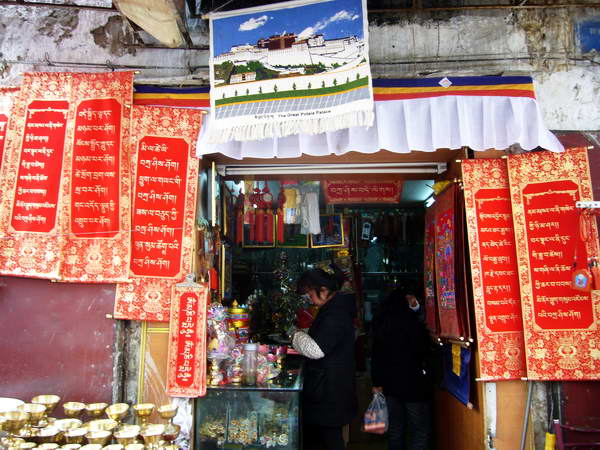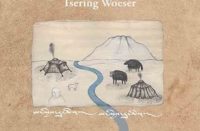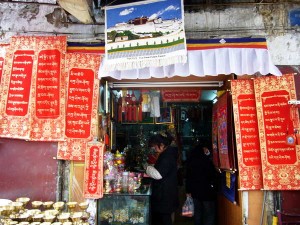High Peaks Pure Earth has translated a blogpost by Woeser that was originally written for Radio Free Asia on February 24, 2010 and posted on her blog on March 4, 2010.
This is the second blogpost that Woeser has written from Lhasa and she vividly describes, in a poetic way, everyday life there with a lot of interesting details. For background information on her trip to Lhasa, see the introduction to the last post she wrote titled “What Is Happiness?” here on High Peaks Pure Earth.
In her final paragraph, Woeser refers to young Tibetans who are proudly asserting their Tibetan identity, she has described it as a kind of “mission” they are on. For an earlier posting on this topic by Woeser see “I Am Tibetan” and don’t miss two videos from Amdo, I Am Tibetan and the hip hop video “New Generation”.
“Lhasa in February”
By Woeser
Lhasa in February, with the arrival of Losar (Tibetan New Year), the city is slowly being swept away by sandstorms. In the past, the storms would never start this early, is global warming the only reason behind this? The Lhasa river valley used to be surrounded by a group of mountains called the “eight lotus petals” but today as it has been completely destroyed by mining machines, as soon as the wind starts to blow, sand and dust spreads everywhere. Also, on top of Lhasa valley, in the past it used to be the homeland of Tsangpo Songtsen Gompo but today even the local Medro Gongkar county government simply sold its own land to one of China Gold Group’s mining companies. The officials lined their own pockets but contaminated water has polluted farmland and even killed livestock or given the farmers strange diseases.
Lhasa in February, with the arrival of Losar, scenes on TV show officials asking the poor about their hardships; they are poor Tibetans from the city of Lhasa or from the remote countryside and pastureland. The officials with their subordinates show off the many hundred Yuan notes, which, with exaggerated gestures, they give to those Tibetans who bend and stick out their tongues (as a sign of respect) or hold out their hands. Also, those Tibetans speaking Lhasa, Shigatse, Nagchu or Chamdo dialects shed tears of gratitude; some even choke with tears, over and over again expressing their eternal gratitude. Yet, if people have to feel this overly thankful for such a little bit of money, doesn’t that mean that their poverty is in fact so widespread and alarming?
Lhasa in February, with the arrival of Losar, red lanterns of all sizes are hanging everywhere. This is by no means a Tibetan custom; it is revealing a different kind of message: the assimilation of local culture by an outside culture. For example, writing red antithetical couplets in Tibetan is really only a strange imitation of an antithetical couplet written in Chinese. They thought that this was just a transformation of old social traditions, but it really is neither fish nor fowl. We should know that all the loss is reflected in the details; every detail meant a little bit of loss and in the end, the loss is complete. It was the local government who initiated that five-starred red flags are now hanging everywhere in the city’s main roads and small alleyways. Cadres went from house to house, from door to door, from shop to shop requesting everyone to hang up a flag. Plus, they especially emphasised that this year people should hang up a particularly big flag. A red flag is also fluttering on the roof of the Potala Palace, pompously declaring national sovereignty.
Lhasa in February, with the arrival of Losar, we can also observe some special colours: one is green, representing soldiers with weapons in their hands, running wild in the streets of Tibet. When one runs into them directly, one has to quickly give way, or else one might with sudden force be pushed aside. There are also some soldiers, who boldly stand on Tibetan people’s rooftops, looking down from above, valiantly pressuring the Tibetans walking below gasping for breath. The other colour is blue, representing the police also carrying weapons in their hands, not just a few of them are Tibetans. I witnessed myself that a young Tibetan who was paying homage to Buddha was pushed away and when he answered back defiantly, Tibetan police clutched his throat. Another colour is always changing. I am not sure how many times these plainclothes policemen have changed their outfits, I even heard that some of them pretend to be Buddhist monks wearing robes wandering around the temples. Or they pretend to be tourists wearing rosaries on their wrists.
Lhasa in February, with the arrival of Losar, I also have to mention these few people: my fellow Tibetan townspeople who I love and respect. They prostrate all their way from various different hometowns to the sacred place – Lhasa – and with the Jokhang and the Potala Palace at their centre, they still continue to prostrate. Of course, the majority of them are farmers, herdsmen and Buddhist monks and nuns, who embody the characteristics of the grassland of the snowy mountains, and who smell of yak butter. When I was walking around the Barkhor I encountered a Buddhist monk whose forehead was full of scabs. He was singing songs in praise of Guru Rinpoche at full volume while slowly prostrating. What will the passing soldiers with their guns in their hands think about Tibetan beliefs?
Lhasa in February, with the arrival of Losar, there are more and more young people who continue to go down the path which belongs to them. They have come back from Chinese universities to their hometowns, wearing Tibetan clothes, speaking their mother tongue, feeling that they are on an “I am Tibetan” mission. And in a cherishing manner they go and learn about the roots of this piece of land, also, when they climb the high mountains to make offering by burning incense, scatter wind-horses, or recite traditional scriptures, they make promises for the future. They are full of self-confidence; they are in their prime, this is exactly the hope which has existed and been multiplied for generations and generations.
Lhasa, February 24, 2010







Follow Us!